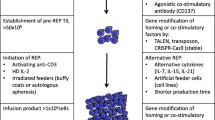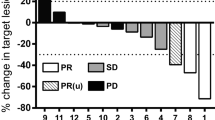Abstract
Freshly isolated tumor-infiltrating lymphocytes (TIL) from stage IV melanoma patients were cultured for 2 weeks with low doses of interleukin-2 (IL-2; 120 IU/ml), to select potentially for tumor-specific lymphocytes present in the neoplastic lesion, followed by high doses (6000 IU/ml) to achieve lymphocyte expansion. TIL were serially analyzed for their expansion, phenotype and cytotoxic activity against autologous and allogeneic tumor cells. A preferential lysis of autologous melanoma cells was obtained in long-term cultures of 7/13 cases (54%), while the remaining ones showed a major-histocompatibility-complex-unrestricted, lymphokine-activated-killer(LAK)-like activity at the time of in vivo injection. Sixteen patients with metastatic melanoma were infused with TIL (mean number: 6.8×109, range: 0.35 × 109−20 × 109) and IL-2 (mean dose: 130 × 106 IU, range: 28.8 × 106−231 × 106 IU); 1 complete and 3 partial responses were observed in 12 evaluable patients (response rate 33%). In all responding patients, injected TIL showed an in vitro preferential lysis of autologous tumor cells, while in no cases were TIL with LAK-like activity associated with a clinical response. The mean autologous tumor cytotoxic activity of TIL at the time of in vivo injection was significantly higher in responding patients in comparison to nonresponding ones, suggesting that a marked and preferential cytolysis of autologous tumor cells is associated with the therapeutic efficacy of TIL.
Similar content being viewed by others
References
Aebersold P, Hyatt C, Johnson S, Hines K, Korcak L, Sanders M, Lotze M, Topalian S, Yang J, Rosenberg SA (1991) Lysis of autologous melanoma cells by tumor-infiltrating lymphocytes: association with clinical response. JNCI 83: 932
Anichini A, Mazzocchi A, Fossati G, Parmiani G (1989) Cytotoxic T lymphocyte clones from peripheral blood and from tumor side detect intratumor heterogeneity of melanoma cells. J Immunol 142: 3692
Blankenstein T, Rowley DA, Schreiber H (1991) Cytokines and cancer: experimental systems. Curr Op Immunol 3: 694
Cascinelli N, Belli F, Marchini S, Marolda R, Prada A, Sciorelli G, Villani F, Gambacorti-Passerini C, Galazka A, Parmiani G (1989) A phase II study of the administration of recombinant interleukin 2 (rIL-2) plus lymphokine activated killer (LAK) cells in stage IV melanoma patients. Tumori 75: 233
Cascinelli N, Belli F, Santinami M, Vaglini M (1992) Chemoimmunotherapy of cutaneous melanoma. In: Dammacco F (ed) Frontiers in autoimmune diseases and cancer immunotherapy. Edi-ermes, Milan, p 273
Crowley NJ, Slingluff CL, Darrow TL, Seigler HF (1990) Generation of human autologous melanoma-specific cytotoxic T-cells using HLA-A2-matched allogeneic melanomas. Cancer Res 50: 492
Darrow TL, Slingluff CL, Seigler HF (1989) The role of HLA class I antigens in recognition of melanoma cells by tumor-specific cytotoxic T lymphocytes. J Immunol 142: 3329
Dillman RO, Oldham RK, Barth NM, Cohen RJ, Minor DR, Birch R, Yannelli JR, Maleckar JR, Sferruzza A, Arnold J, West WH (1991) Continuous interleukin-2 and tumor-infiltrating lymphocytes as treatment of advanced melanoma. Cancer 68: 1
Giacomini P, Fraioli R, Calabro' AM, Di Filippo F, Natali PG (1991) Class I major histocompatibility complex enhancement by recombinant leukocyte interferon in the peripheral blood mononuclear cells and plasma of melanoma patients. Cancer Res 51: 652
Hoogstraten B (1988) Reporting treatment results in solid tumor. In: Buyse ME, Staquet MJ, Sylvester RJ (eds) Cancer clinical trials, methods and pratice. Oxford, Oxford University Press, p 139
Kradin RL, Lazarus DS, Dubinett SM, Gifford J, Grove B, Kurnick JT, Preffer FI, Pinto CE, Davidson E, Callahan RJ, Strauss HW (1989) Tumor-infiltrating lymphocytes and interleukin-2 in treatment of advanced cancer. Lancet I: 577
Margolin KA, Rayner AA, Hawkins MJ, Atkins MB, Dutcher JP, Fisher RI, Weiss GR, Doroshow JH, Jaffe HS, Roper M, Parkinson DR, Wiernik PH, Creekmore SP, Boldt DH (1989) Interleukin-2 and lymphokine-activated killer cell therapy of solid tumor: analysis of toxicity and management guidelines. J Clin Oncol 7: 486
Mastrangelo MJ, Berd D, Maguire H (1986) The immunoaugmenting effects of cancer chemotherapeutic agents. Semin Oncol 13: 186
Mitchell MS, Harel W, Groshen S (1992) Association of HLA phenotype with response to active specific immunotherapy of melanoma. J Clin Oncol 10: 1158
Natali PG, Nicotra MR, Bigotti A, Venturo I, Marcenaro L, Giacomini P, Russo C (1989) Selective changes in expression of HLA class I polymorphic determinants in human solid tumors. Proc Natl Acad Sci USA 86: 6719
Parmiani G, Anichini A, Carbone G, Sensi ML (1992) Can oncogene (RAS) activation predict susceptibility of human melanoma to activated lymphocytes and, therefore, the clinical response of such neoplasms to adoptive immunotherapy? Melanoma Res 2: 123
Radrizzani M, Gambacorti-Passerini C, Parmiani G, Fossati G (1989) Lysis by interleukin 2-stimulated tumor-infiltrating lymphocytes of autologous and allogeneic tumor target cells. Cancer Immunol Immunother 28: 67
Rivoltini L, Arienti F, Orazi A, Cefalo G, Gasparini M, Gambacorti-Passerini C, Fossati-Bellani F, Parmiani G (1992) Phenotypic and functional analysis of lymphocytes infiltrating paediatric tumours, with a characterization of the tumour phenotype. Cancer Immunol Immunother 34: 241
Rosenberg SA (1992) The immunotherapy and gene therapy of cancer. J Clin Oncol 10: 180
Rosenberg SA, Packard BS, Aebersold PM, Solomon D, Topalian SL, Toy ST, Simon P, Lotze MT, Yang JC, Seipp CA, Simpson C, Carter C, Bock S, Schwartzentruber D, Wei JP, White DE (1988) Use of tumor infiltrating lymphocytes and interleukin-2 in the immunotherapy of patients with metastatic melanoma. A preliminary report. N Engl J Med 319: 1676
Rosenberg SA, Schwarz SL, Spiess PJ (1988) Combination immunotherapy for cancer: synergistic antitumor interactions of interleukin-2, alpha-interferon, and tumor-infiltrating lymphocytes. JNCI 80: 1393
Sondel PM, Kohler PC, Hank JA, Moore KH, Rosenthal NS, Sosman JA, Bechhofer R, Storer B (1988) Clinical and immunological effects of recombinant interleukin-2 given by repetitive weekly cycles to patients with cancer. Cancer Res 48: 2561
Topalian SL, Solomon D, Avis FP, Chang AE, Freerksen DL, Linehan WM, Lotze MT, Robertson CN, Seipp CA, Simon P, Simpson CG, Rosenberg SA (1988) Immunotherapy of patients with advanced cancer using tumor-infiltrating lymphocytes and recombinant interleukin-2. A pilot study. J Clin Oncol 6: 839
Topalian SL, Solomon D, Rosenberg SA (1989) Tumor-specific cytolysis by lymphocytes infiltrating human melanomas. J Immunol 142: 3714
van der Bruggen P, Traversari C, Chomez P, Lurquin C, De Plaen E, Van den Eynde B, Knuth A, Boon T (1991) A gene encoding an antigen recognized by cytolytic T lymphocytes on a human melanoma. Science 254: 1643
Vanky F, Wang P, Patarroyo M, Klein E (1990) Expression of the adhesion molecule ICAM1 and major histocompatibility complex class I antigens on human tumor cells is required for their interaction with autologous lymphocytes in vitro. Cancer Immunol Immunother 31: 19
Weber JS, Rosenberg SA (1990) Effect of murine tumor class I major histocompatibility complex expression on anti-tumor activity of tumor-infiltrating lymphocytes. JNCI 82: 755
Yang JC, Perry-Lalley D, Rosenberg SA (1990) An improved method for growing murine tumor-infiltrating lymphocytes with in vivo antitumor activity. J Biol Response Mod 9: 149
Author information
Authors and Affiliations
Rights and permissions
About this article
Cite this article
Arienti, F., Belli, F., Rivoltini, L. et al. Adoptive immunotherapy of advanced melanoma patients with interleukin-2 (IL-2) and tumor-infiltrating lymphocytes selected in vitro with low doses of IL-2. Cancer Immunol Immunother 36, 315–322 (1993). https://doi.org/10.1007/BF01741170
Received:
Accepted:
Issue Date:
DOI: https://doi.org/10.1007/BF01741170




